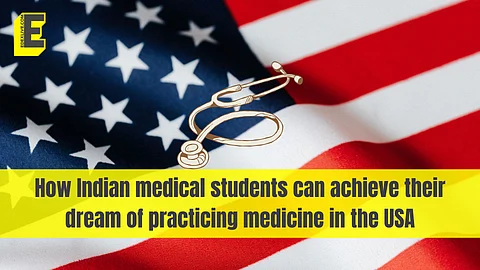

For many Indian medical aspirants, the ultimate goal isn’t just becoming a doctor — it’s wearing the white coat in a globally renowned hospital, conducting research at leading institutions, and making a mark in the world’s most advanced healthcare system: the United States. While the path to practicing medicine in the US as an Indian student is demanding, it is far from impossible. With the right planning, mentorship, and preparation, this dream can become a reality.
Understanding the medical pathway in the US
Unlike India, where students begin MBBS right after Class 12, the US follows a longer, multi-step route. Students must first complete a 4-year undergraduate or pre-medical degree, often in a science-related field like biology or chemistry, and clear the MCAT (Medical College Admission Test). Only then can they apply for an MD (Doctor of Medicine) or DO (Doctor of Osteopathic Medicine) programme.
Medical school in the US spans four years and includes both classroom instruction and clinical training. Students take the USMLE (United States Medical Licensing Examination) Step 1 at the end of their second year and Step 2 in their fourth year.
Upon graduating, they apply through the NRMP (National Resident Matching Program) to secure a residency, which is a specialty-specific training programme lasting three to seven years. USMLE Step 3 is typically taken during the first or second year of residency.
Some doctors pursue further specialization through fellowships. To practice independently, physicians must also obtain a medical license from the state where they plan to work, as each US state has its own licensure requirements.
Pursuing MBBS in India with a US dream
If you're studying MBBS in India, it’s essential to begin preparing for the USMLE by your second or third year. Since many Indian medical colleges don’t follow USMLE-style integrated or problem-based curricula, self-study or enrolling in a dedicated prep course is crucial.
Additionally, Indian students need to gain US clinical experience, usually through electives, clerkships, or observerships during the later years of MBBS. These not only provide exposure to the US healthcare system but also help in securing strong letters of recommendation, which are vital for residency applications. However, international medical graduates (IMGs) often face challenges, including limited guidance and greater competition for US residency slots.
Choosing international dathways Designed for the US
An increasingly popular alternative is enrolling in international medical schools specifically structured to align with US and global licensure pathways. Some of these schools, especially in the Caribbean, offer US-style curricula, are accredited by recognized bodies, and are listed in the World Directory of Medical Schools. Many also facilitate clinical rotations in the US and integrate USMLE preparation into their programmes.
These pathways are appealing because they combine international exposure, access to US hospital systems, and a multicultural learning environment, all of which strengthen residency applications.
Preparing for the USMLE and Residency Match
Success in the USMLE, especially Step 1 and Step 2 CK, is pivotal. But beyond high scores, applicants must build a strong, well-rounded profile. This includes US clinical rotations, research experience, community service, and excellent communication skills. The NRMP evaluates candidates based on their academic achievements as well as their personal qualities during the residency match process.
Mentorship from seniors or alumni who have successfully matched in the US can also provide invaluable guidance, ranging from choosing programmes to writing personal statements and preparing for interviews.
Key Considerations for Indian Aspirants
Start early: Whether in high school or medical college, early exposure through summer programmes, shadowing, or research helps.
Be informed: Understand licensing and visa requirements. For example, foreign medical graduates must be certified by the Educational Commission for Foreign Medical Graduates (ECFMG) to enter US residency.
Invest in quality: Choose institutions aligned with USMLE standards and offering US clinical exposure.
Stay resilient: The journey is long and demanding, marked by competitive exams, financial investment, and occasional setbacks. "However, the personal and professional gains at the end of the journey make the effort worthwhile
As the US continues to face a growing demand for skilled physicians, Indian students, equipped with strong academic foundations and a global outlook, are uniquely positioned to rise to the occasion.
With determination and strategic planning, the dream of becoming a doctor in the US can be transformed into a remarkable reality.
(Arunesh Kumar, Country Head - India & South East Asia, Manipal’s American University of Antigua (AUA) College of Medicine. Views expressed are their own.)
